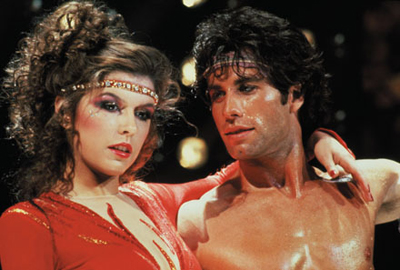|
|
Chapter TwoStaying AliveBy Brett Ballard-BeachJuly 21, 2011
To make the kickoff of this Chapter Two mini-fest - which I have just now decided to call “How Bad Do You Want It?” - a little more interesting, I will resist the obvious. Instead of focusing on John Travolta, the STAR - for a film and performance like this only all caps will do - I will begin with an eye turned to the auteur who was co-writer, co-producer and director on this Grammy, Golden Globe and Razzie-nominated project. Sylvester Stallone has directed eight movies to date and written or co-written about 20 screenplays. These figures include helming four of the six Rocky movies (as well as writing all the screenplays) and the most recent Rambo (and sharing co-writing status on all four in that series), and notching at least a co-writing credit on most all of his 1980s output - films as disparate as Rhinestone, Cobra and Over the Top included. It is helpful to remember that Stallone turned to screenwriting in the mid-1970s as his acting career was fizzling and that in the post-Rocky world, his cachet led to two produced screenplays in 1978: F*I*S*T and Paradise Alley. Stallone starred in both and made his directorial debut with the latter. He was recruited by Travolta to be the director of Staying Alive and turned down an offer to play the director of Satan’s Alley, the musical within the movie. Staying Alive marks the only film he has directed where he does not have a leading role, or in fact a “role” of any kind. He has a five second blink-and-you-miss-it walk-on (cameo would be too strong a word) and if nothing else, you can pull Staying Alive up on any one of your friendly household media players and see if you can spot him. Those less inclined to play along can skip ahead to the end of the column. One of the things I hope to do with my discussion of the film is to see what Stallone offers the sequel and determine for myself if it is as odd a fit as I have always thought it would (and should) be. Staying Alive is technically a sequel to 1977’s Saturday Night Fever, and it feels strange to use that word “technically” since the film was marketed explicitly as being the further adventures of Tony Manero - Brooklyn stud, conflicted man-child, and disco dancer (now determined would-be Broadway dancer) par excellence. I opt for it for several reasons relating to both aesthetics and plot issues. The film take place five years after Fever and features obvious references to the prior film - a shot of the disco club 2001 Odyssey, the character of Tony’s mother, a closing sequence in which The Bee Gees’ Stayin’ Alive plays over Tony strutting - but has far more plot holes and fissures that one either wrestles with and finds distressing or completely ignores, thus negating the need for this to be a sequel to Saturday Night Fever.
|

|
|
|

|
Friday, November 1, 2024
© 2024 Box Office Prophets, a division of One Of Us, Inc.


